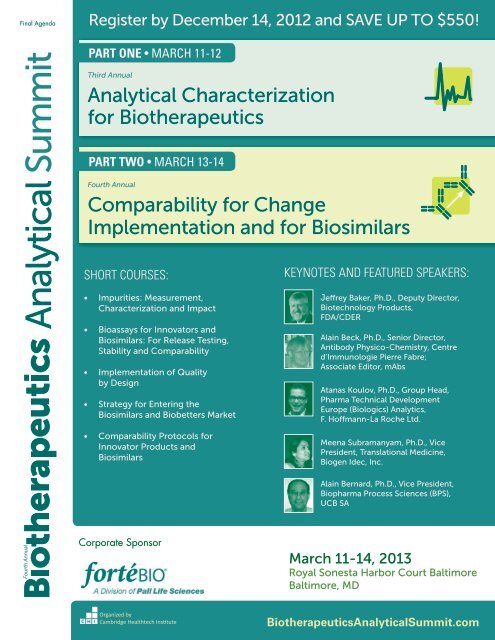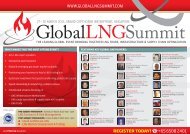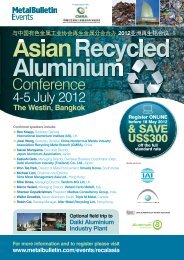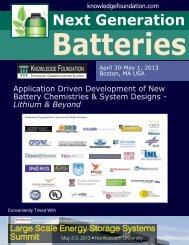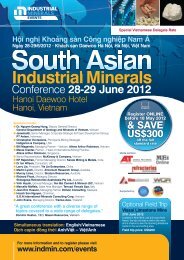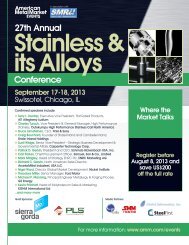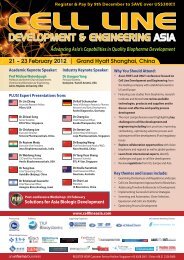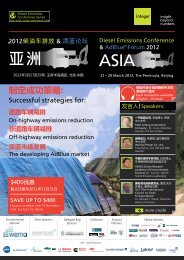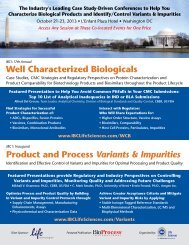Analytical Summit
Analytical Summit
Analytical Summit
Create successful ePaper yourself
Turn your PDF publications into a flip-book with our unique Google optimized e-Paper software.
Final AgendaRegister by December 14, 2012 and save up to $550!<strong>Analytical</strong> <strong>Summit</strong>Part one • March 11-12Third Annual<strong>Analytical</strong> Characterizationfor BiotherapeuticsPart two • March 13-14Fourth AnnualComparability for ChangeImplementation and for BiosimilarsShort Courses:• Impurities: Measurement,Characterization and Impact• Bioassays for Innovators andBiosimilars: For Release Testing,Stability and Comparability• Implementation of Qualityby Design• Strategy for Entering theBiosimilars and Biobetters Marketkeynotes and featured speakers:Jeffrey Baker, Ph.D., Deputy Director,Biotechnology Products,FDA/CDERAlain Beck, Ph.D., Senior Director,Antibody Physico-Chemistry, Centred’Immunologie Pierre Fabre;Associate Editor, mAbsAtanas Koulov, Ph.D., Group Head,Pharma Technical DevelopmentEurope (Biologics) Analytics,F. Hoffmann-La Roche Ltd.• Comparability Protocols forInnovator Products andBiosimilarsMeena Subramanyam, Ph.D., VicePresident, Translational Medicine,Biogen Idec, Inc.Alain Bernard, Ph.D., Vice President,Biopharma Process Sciences (BPS),UCB SAFourth AnnualCorporate SponsorMarch 11-14, 2013Royal Sonesta Harbor Court BaltimoreBaltimore, MDOrganized byCambridge Healthtech InstituteBiotherapeutics<strong>Analytical</strong><strong>Summit</strong>.com
Hotel & TravelConference Hotel:Royal Sonesta Harbor Court Baltimore550 Light StreetBaltimore, MD 21202(410) 234-0550Room Rate: $199 s/d (rate includescomplimentary wireless internetaccess in guest room)Reservation Cutoff: February 15, 2013Visit our conference website to makeyour reservations online or call thehotel directly to reserve your sleepingaccommodation. You will need toidentify yourself as a CHI conferenceattendee to receive the discountedroom rate with the host hotel.Reservations made after the cut-offdate or after the group room blockhas been filled (whichever comes first)will be accepted on a space and rateavailabilitybasis. Rooms are limited,so please book early to take advantageof the discount we have negotiated.We understand that you have manychoices when making your travelarrangements, and may ultimatelydecide to stay at another hotel.Please understand that reservingyour room in the CHI room blockallows you to take full advantage ofthe conference sessions, events andnetworking opportunities, and ensuresthat our staff will be available to helpshould you have any issues with youraccommodation.Flight Discounts:Special discounts have beenestablished with American Airlines forthis conference:• Call 1-800-433-1790 useConference code 5633BV• Go to www.aa.com/group enterConference code 5633BV inpromotion discount box• Contact our designatedtravel agent, Wendy Levineat 1-877-559-5549 orwendy.levine@protravelinc.com.Car Rental Discounts:Special discount rentals have beenestablished with Hertz for thisconference.• Call Hertz directly at800-654-3131 and reference ourDiscount Number 04KL0004Sponsorship, Exhibit,and Lead GenerationOpportunitiesCHI offers comprehensive sponsorship packages whichallow you to achieve your objectives before, during, and longafter the event. Signing on early will allow you to maximizeexposure to hard-to-reach decision makers!Agenda PresentationsShowcase your solutions to a guaranteed, highly-targetedaudience. Package includes a 15 or 30-minute podiumpresentation within the scientific agenda, exhibit space, onsitebranding, and access to cooperative marketing efforts byCHI.Breakfast & Luncheon PresentationsOpportunity includes a 30-minute podium presentation.Boxed lunches are delivered into the main session room,which guarantees audience attendance and participation. Alimited number of presentations are available for sponsorshipand they will sell out quickly. Sign on early to secure your talk!Web SymposiaCHI's Web Symposia are powerful lead generation tools, aswell as an effective vehicle to communicate with your targetaudience. Connect with key prospects through our newweb symposium series. CHI produces agenda, promotesthe symposia, and manages all of the logistics. Sponsors willreceive a minimum of 100 qualified leads. Call for details.Invitation-Only VIP Dinner/Hospitality SuiteSponsors will select their top prospects from the conferencepre-registration list for an evening of networking at the hotelor at a choice local venue. CHI will extend invitations anddeliver prospects. Evening will be customized according tosponsor’s objectives:• Purely social• Focus group• Reception style• Plated dinner with specific conversation focus*Inquire about additional branding opportunities!Amtrak Discounts:Amtrak offers a 10% discount off thebest available rail fare to Baltimore-Penn Station, MD between March8-16, 2013. To book your reservationcall Amtrak at 1-800-872-7245 orcontact your local travel agent.Discount fares cannot be booked viainternet.Please be sure to refer to ConventionFare Code X63L-956 when makingyour reservation. This offer is not validon the Auto Train and Acela Service.Fare is valid on Amtrak Regional for alldepartures seven days a week, exceptfor holiday blackouts. Offer validwith Sleepers, Business Class or FirstClass seats with payment of the fullapplicable accommodation charges.ExhibitExhibitors will enjoy facilitated networking opportunities withhigh-level conference delegates. Speak face-to-face withprospective clients and showcase your latest product, service,or solution.Looking for additional ways to driveleads to your sales team? CHI can help!We offer clients numerous options for custom leadgeneration programs to address their marketing and salesneeds, including:• Live Webinars• White Papers• Market Surveys• Podcasts and More!To customize your participation at this event, please contact:Jon StroupBusiness Development Manager781-972-5483 | jstroup@healthtech.comBiotherapeutics<strong>Analytical</strong><strong>Summit</strong>.com 2Biotherapeutics <strong>Analytical</strong> <strong>Summit</strong>
Short Courses *Monday, March 11 • 9:00 am – 12:00 pmSC1: Impurities: Measurement, Characterization and ImpactInstructors:Nanda Subbarao, Ph.D., Senior Consultant, <strong>Analytical</strong> CMC, Biologics Consulting GroupMatthew Seefeldt, Ph.D., CSO, Barofold, Inc.Jun Liu, Ph.D., Senior Scientist and Senior Group Leader, Late Stage PharmaceuticalDevelopment, Genentech, Inc.This short course will examine the nature of process and product related impurities thatcan be present in biotechnology products, and their clinical impact. It will provide anoverview of current regulatory expectations and advice on ‘best practices’ for impurityassessment during different stages of product development. Three leading types ofimpurities will be examined in greater detail, using a key example of each to review thecurrent and emerging issues for biotechnology products associated with each.• Impurities in biotechnology/biosimilar products – What makes them critical?• Example of critical process-related impurities: Host cell proteins• Example of critical product-related impurities: Soluble aggregates and particulates• Example of critical container/closure related impurities: Extractables/leachables• Open discussion with Q&ASC2: Bioassays for Innovators and Biosimilars: For ReleaseTesting, Stability and ComparabilityInstructors:Timothy Schofield, M.A., Head, Nonclinical Statistics Services, Arlenda, Inc.; Co-Chair,Statistics Expert Committee, USPXu-Rong Jiang, Ph.D., M.D., Associate Director, <strong>Analytical</strong> Biochemistry, MedImmune, Inc.This interactive short course will enable attendees to develop methods and strategies fordeveloping and validating bioassays that support the identification and development oftheir biotherapeutics products. It will include coverage of assays to test both activity andpotency, including cell-based and biochemical based systems.• Similarity testing (parallelism): Re-molding validation and QBD• Variance component analysis / ruggedness design• Validation analysis to satisfying the agencies: A box checking exercise requiringmultiple runs of bioassays to give precise results• Control strategy and standard qualification• Overview on measuring effector function• Tools for bioassays• FDA advice on bioassays• Bioassay strategy for a biosimilar: How this compares with innovators• Open Discussion with Q&AWednesday, March 13 • 5:30 – 8:30 pm (Dinner will be provided)Dinner SC3: Implementation of Quality by DesignInstructors:Timothy Schofield, M.A., Head, Nonclinical Statistics Services, Arlenda, Inc.; Co-Chair,Statistics Expert Committee, USPMichele Dougherty, Ph.D., Product Quality Reviewer, Monoclonal Antibodies, FDAThis short course will examine the benefits of QBD in terms of establishing a risk-basedlife-cycle management approach, and outline approaches for identifying critical qualityattributes and acceptable ranges and identification of critical process parameters. Itwill clarify the challenges of QBD implementation, describing the tools required, andinclude examples and case studies regarding determination of CQA and design space,applications to existing cell culture and manufacturing processes, control of the process,control of the presence of impurities and application for comparability purposes. Inaddition, the regulatory benefits will be outlined together with advice on putting togethera QBD application and working together with the regulatory authorities.• QBD for controlling and understanding the process• Managing risk using your process and analytical control strategies• Designing a risk-based control strategy for maintaining quality• FDA advice regarding implementation of quality by design• Open Discussion with Q&ADinner SC4: Strategy for Entering the Biosimilars andBiobetters MarketInstructors:Strategy for Entering the Biosimilars MarketChristopher J. Holloway, Ph.D., Dr.rer.hum.biol.habil., Group Director, Regulatory Affairs& CSO, ERA Consulting Group<strong>Analytical</strong> Tools for Characterizing Biosimilars, Biobetters and Next-GenerationAntibodies with Enhanced PropertiesAlain Beck, Ph.D., Senior Director, Antibody Physico-Chemistry, Centre d’ImmunologiePierre Fabre; Associate Editor, mAbsBiologics Price Competition and Innovation Act of 2009: FDA’s Overview of theRegulatory Guidance for the Development and Approval of Biosimilar Productsin the USMarjorie A. Shapiro, Ph.D., Chief, Laboratory of Molecular and DevelopmentalImmunology, Division of Monoclonal Antibodies, CDER/FDALegal Issues to Consider for BiosimilarsDonald L. Zuhn, Jr., Ph.D., Partner, McDonnell, Boehnen, Hulbert & Berghoff LLPDiscussion with Q&APlease see website for further details.Thursday, March 14 • 1:30 – 4:30 PMSC5: Comparability Protocols for Innovator Products and BiosimilarsInstructors:Christopher J. Holloway, Ph.D., Dr.rer.hum.biol.habil., Group Director,Regulatory Affairs & CSO, ERA Consulting GroupSheila Magil, Ph.D., Senior Consultant, Bioprocess Technology Consultants, USANanda Subbarao, Ph.D., Senior Consultant, <strong>Analytical</strong> CMC, Biologics Consulting GroupMike Nedved, Ph.D., <strong>Analytical</strong> Development, Engineering & Research & Development,Johnson & Johnson, Inc.Manufacturing changes can impact on quality attributes of biologics, and may affectefficacy and/or safety of the product. For that reason, a thorough comparability exerciseis required, to assess the impact of the change and whether CMC data alone will sufficeto support the change. In the case of biosimilar products, an extensive comparabilityexercise is required to substantiate the claim of biosimilarity. This interactive short coursewill consider comparability exercises during development, as well as post-approval,addressing regulatory and technical requirements. This should provide the attendeewith the knowledge on how to prepare a comparability package for discussion withregulatory agencies, towards acceptance of the proposed change to the process/product.• The comparability exercise during development; strategies in early and latedevelopment• Post-approval comparability, ICH Q5E, Comparability Protocols (US) and ChangeManagement Protocols (EU)• Regulatory requirements, guidelines, their interpretation and application• Technical requirements for comparability exercises• Critical evaluation of quality data; when are CMC data not enough?• Case studies in comparability exercises; some successes and failures• Discussion, Q&A• Including a presentation on Practical Aspects of Setting Up the Biochemical/Biophysical/Biological Comparability Protocol Documents Used for Early and LateDevelopment Comparability Studies for Primarily Monoclonal Antibodies*Separate Registration RequiredBiotherapeutics<strong>Analytical</strong><strong>Summit</strong>.com 3Biotherapeutics <strong>Analytical</strong> <strong>Summit</strong>
Part one • March 11-12Third Annual<strong>Analytical</strong> Characterization for BiotherapeuticsMethodology and Practical ApplicationMonday, March 1112:00 pm Registration2:00 Chairperson’s Opening RemarksADVANCES IN ANALYTICAL TECHNOLOGY FORCHARACTERIZATION»»KEYNOTE PRESENTATION2:05 <strong>Analytical</strong> Tools for Characterizing Biosimilars, Biobettersand Next-Generation Antibodies with Enhanced PropertiesAlain Beck, Ph.D., Senior Director, Antibody Physico-Chemistry, Centred’Immunologie Pierre Fabre; Associate Editor, mAbsMultiple and complementary Mass Spectrometry (MS) methods are used at allstages of mAbs discovery, preclinical, and clinical development. MS methods arekey techniques used for identification of “hot spots” which may be deleterious forstability, for PK, and for pharmacology properties. In the past decade, severalhundred papers have been published on mAbs characterization by MS. As aresult, deep insights into structure−function relationships of this leading class ofpharmaceuticals have been gained. The early use in the R&D process of MSmethods helps to optimize the structure of next-generation mAbs allowing thedevelopment of drug-candidates with reduced chemistry manufacturing and controlliabilities.2:35 An Evaluation of the Higher Order Structure and BiologicalActivity of an Oxidized IgG2 Monoclonal AntibodyJohn Gabrielson, Ph.D., Principal Scientist, <strong>Analytical</strong> Sciences, Amgen, Inc.The effect of hydrogen peroxide oxidation on higher order structure and biologicalactivity was assessed for an IgG2 therapeutic molecule. Even at high levels ofoxidation (> 80%), the molecule’s secondary and tertiary structures, as well as sizevariant distribution remained comparable to the control sample (5% oxidation).Conversely, relative binding to FcRn declined linearly with increasing methionineoxidation, and changes in thermal stability were detected at 40% oxidation,before in vitro potency was affected. This case study highlights the potential valueof thermal stability measurements to predict domain-specific higher order structuralchanges that impact biological activity.3:05 Proteomic Approaches as Support for the In-DepthCharacterization of BiosimilarsFlorian Wolschin, Ph.D., Lab Head, <strong>Analytical</strong> Characterization, Sandoz GmbHProteomic approaches that allow for a sensitive and fast characterization ofprotein mixtures have the potential to tremendously increase our knowledge ofbiologics. However, such approaches have not yet been used extensively for thein-depth characterization of biosimilars. We present a set of mass spectrometrybasedtools including shotgun and top-down proteomics, which we use for thehighly sensitive detection of HCPs (host cell proteins) and protein variants inbiosimilar samples.3:35 Refreshment Break in the Exhibit Hall with Poster ViewingCHARACTERIZATION OF SPECIFIC PRODUCTS4:00 Developmental Challenges with Multi-Target RecombinantAntibody MixturesTorben P. Frandsen, Ph.D., Vice President, Preclinical R&D, Antibody CMC,Symphogen A/SRecombinant antibody mixtures are presently being evaluated as drug candidatesto treat serious indications especially within the oncology field. Qualitycharacteristics and manufacturability of individual antibodies during the selectionprocess for antibody mixture lead candidate is of fundamental importance tomitigate further CMC development. Assessment of individual quality characteristicsis a key element for the successful development of project specific identity methods.This presentation will address the analytical and developmental challengesof antibody mixtures relative to monoclonal products and will shown differentexamples of used analytical methodologies.4:30 Implementation of Automated Quantitative CE-BasedSimple Western Technology for Vaccine or Therapeutic ProteinDevelopmentRichard R. Rustandi, Ph.D., Research Fellow, Vaccine <strong>Analytical</strong> Department,Merck & Co.Many CE-based technologies such as icIEF, CE-SDS, and CZE are well establishedfor analyzing proteins, viruses, or polysaccharides. For example, icIEF andCE-SDS are standard replacement methods in biopharmaceutical industries fortedious and labor intensive IEF and SDS-PAGE methods, respectively. Anotherimportant analytical tool for protein characterization is a Western blot. Currently,the procedure is very manual, laborious and time consuming. Here, we implementa new CE-based technology called Simple Western for performing automatedWestern analysis for vaccine and therapeutic protein programs. Applicationsof this new technology will be discussed with respect to protein quantitation,fermentation support, and mAbs screening.5:00 Physicochemical Characterization of Antibody-DrugConjugatesKevin Anderson, Ph.D., Senior Principal Scientist, <strong>Analytical</strong> Biochemistry,Seattle Genetics, Inc.This talk will emphasize quality attributes, and describe analytical tools andanalytical challenges unique to ADCs.TOOLS AND APPROACHES FOR DETERMININGSEQUENCE VARIATION5:30 Use of the Stable Isotope-Tagged Reference StandardMethod for Detection of Sequence VariantsDavid H. Lee, Ph.D., Principal Research Scientist, Process Sciences, AbbottBioresearch CenterDescribed in this presentation is a quantitative mass spectrometry approach, theSITRS method, which provides high resolution comparability of therapeutic proteinsat the peptide level. Its utility in discovering and quantitating sequence variants willbe discussed.6:00 End of Day One of <strong>Analytical</strong> CharacterizationJoin the Biotherapeutics <strong>Analytical</strong> <strong>Summit</strong>Group on Linked InFollow us on Twitter@chi_healthtechBiotherapeutics<strong>Analytical</strong><strong>Summit</strong>.com 4Biotherapeutics <strong>Analytical</strong> <strong>Summit</strong>
Tuesday, March 12POST-TRANSLATIONAL MODIFICATIONS8:30 am Chairperson’s Remarks8:35 Characterization of Monoclonal Antibody ChargedIsoforms by IEX HPLC, icIEF, Enzymatic Digest and LC-MS/MSTanya Mezhebovsky, Ph.D., A.L.M., Group Leader, Assay and FormulationDevelopment, Biochemistry Development, Morphotek, a member of Eisai GroupIn monoclonal antibodies, charged isoforms arise primarily due to differencesin sialic acid content of the complex N-linked oligosaccharides attached tothe antibody, as well as post-translational modifications of polar amino acids.These variants can be separated by ion exchange chromatography andcapillary electrophoresis. Identification and characterization of charged isoformsin monoclonal antibodies using both separation methods, in combinationwith enzymatic digestions, forced degradation sample analysis and LC-MSmethodology will be presented, with emphasis on optimization of samplepreparation.9:05 Glyco-Engineering Strategies to Improve BiologicalActivity of Antibody TherapeuticsShantha Raju, M.Sc., Ph.D., Scientific Director, Biologics Research,Centocor, Inc.9:35 Data Required for Characterization and ComparabilityRegarding Glycosylation of Biosimilar CandidatesAdriana E. Manzi, Ph.D., President & Managing Director, TechnicalConsulting Group, Atheln, Inc.The modification of proteins by post-translational addition of complexglycans results in great structural diversity. The structures of N- and O-linkedoligosaccharides depend on the particular expression system utilized and inaddition are susceptible to changes in the conditions of the culture. Many of theblockbuster biologics loosing patent protection in the near future are glycosylatedmolecules. Therefore, demonstration of biosimilarity of the candidates underdevelopment needs to include a thorough evaluation of their glycosylation sincethese products will be manufactured using different cell lines and processes thanthe originator molecule. The talk will focus on the analysis of glycans during thedevelopment of a biosimilar candidate.10:05 Sponsored PresentationSpeaker to be Announced10:35 Coffee Break in the Exhibit Hall with Poster ViewingSponsored byMEASUREMENT, CHARACTERIZATION ANDIMPACT OF IMPURITIES»»FEATURED PRESENTATION11:00 Emerging Techniques for Submicrometer ParticleCharacterization in BiotherapeuticsAtanas Koulov, Ph.D., Group Head, Pharma Technical Development Europe(Biologics) Analytics, F. Hoffmann-La Roche Ltd.11:30 Current Strategies for Controlling Soluble Aggregatesand Sub-Visible Particles in Therapeutic ProteinsJun Liu, Ph.D., Senior Scientist and Senior Group Leader, Late StagePharmaceutical Development, Genentech, Inc.12:00 pm Elimination of Aggregates and ReducedImmunogenicity of IFN-beta-1b through High PressureRefoldingMatthew Seefeldt, Ph.D., CSO, Barofold, Inc.IFN-beta-1b is an effective therapy in multiple sclerosis treatment. Unfortunately,patients develop neutralizing antibodies to the therapy over time with the roleof aggregation in instigating immunogenicity debated. BaroFold hypothesizedthat the removal of aggregates would decrease immunogenicity and the resultingproduct is now in Phase III clinical studies via our licensee Nuron Biotech. Thepresentation will review the effectiveness of high pressure treatment for thereduction of aggregates and subvisible particulates in final formulations, examinethe correlations between reduced aggregate levels and immunogenicity, anddiscuss the applications of high pressure treatment for other biosimilar candidates.12:30 Luncheon Presentation (Opportunity available, please contactJon Stroup, jstroup@healthtech.com) or lunch on your ownADVANCES IN BIOASSAYS AND FUNCTIONALCHARACTERIZATION2:00 Chairperson’s Remarks2:05 Development of a Cell-Based Migration Assay for PotencyRelease TestingXu-Rong Jiang, Ph.D., M.D., Associate Director, <strong>Analytical</strong> Biochemistry,MedImmune, Inc.2:35 Therapeutic Antibody Characterization and ComparabilityUsing Fc Receptor Binding AssaysJeffrey K. Glenn, Ph.D., Associate Director, <strong>Analytical</strong> Development,Janssen R&DFc-relevant bioactivity assays such as antibody-dependent cell cytotoxicity(ADCC), and complement-dependent cytotoxicity (CDC), are now standard forcharacterization and stability evaluation of therapeutic antibodies with knownFc effector function. In the last few years focus has turned to Fc analysis of IgGswithout defined Fc effector function. Janssen R&D has instituted a standardpanel of tests which include FcγRI and FcRn receptor binding assays, and whereappropriate, FcγRIIIa binding assay as a surrogate for ADCC. These assay formatswill be described along with representative data, and comparison of Fc bindingand ADCC bioassay results for one product will be shown.3:05 Updates on Standards for Bioassays from the USPMaura C. Kibbey, Ph.D., Senior Scientific Liaison, U.S. Pharmacopeia3:35 Sponsored Presentation (Opportunity available, pleasecontact Jon Stroup, jstroup@healthtech.com)4:05 Refreshment Break in the Exhibit Hall with Poster Viewing4:30 – 5:30 Breakout DiscussionsTable 1: Benefits and Challenges of Advances in <strong>Analytical</strong>Technology for Characterizing the Higher-Order Structure ofBiopharmaceuticalsModerator: John Gabrielson, Ph.D., Principal Scientist, <strong>Analytical</strong> Sciences,Amgen, Inc.Table 2: Evaluation of Post-Translational Modification HotSpots and Liability SitesModerator: Tanya Mezhebovsky, Ph.D., A.L.M., Group Leader, Assay andFormulation Development, Biochemistry Development, Morphotek, amember of Eisai GroupTable 3: Glycosylation as a Strategy to Improve Antibody-Based TherapeuticsModerator: Shantha Raju, M.Sc., Ph.D., Scientific Director, BiologicsResearch, Centocor, Inc.Table 4: Challenges with Protein Aggregation and SubvisibleParticle FormationModerator: Jun Liu, Ph.D., Senior Scientist and Senior Group Leader, LateStage Pharmaceutical Development, Genentech, IncTable 5: Satisfying Regulatory Requirements RegardingBioassays for CommercializationModerator: Jeffrey K. Glenn, Ph.D., Associate Director, <strong>Analytical</strong>Development, Janssen R&DTable 6: Reference Standards for Potency of the ProductModerator: Xu-Rong Jiang, Ph.D., M.D., Associate Director, <strong>Analytical</strong>Biochemistry, MedImmune, Inc.5:30 Reception in the Exhibit Hall with Poster Viewing6:30 Close of <strong>Analytical</strong> CharacterizationBiotherapeutics<strong>Analytical</strong><strong>Summit</strong>.com 5Biotherapeutics <strong>Analytical</strong> <strong>Summit</strong>
Part TWO • March 13-14Fourth AnnualComparability for Change Implementation and for BiosimilarsMeet the regulatory authorities and develop a comparability strategy for your productWednesday, March 138:00 am Registration and Morning CoffeeESTABLISHING ANALYTICAL SUPPORT FORMANUFACTURING8:30 Chairperson’s Opening Remarks»»FEATURED PRESENTATION8:35 <strong>Analytical</strong> Controls : How to Know What We Don’t KnowAlain Bernard, Ph.D., Vice President, Biopharma Process Sciences (BPS),UCB SA9:05 Defining Product Quality Targets during DevelopmentYung-Hsiang Kao, Ph.D., Principal Scientist and Senior Group Leader, Protein<strong>Analytical</strong> Chemistry, Genentech, Inc.9:35 Development of Novel <strong>Analytical</strong> Tools for cGMPManufacture of Recombinant Targeted Secretion Inhibitors(TSIs)Andy Hooker, Ph.D., Head, CMC and Quality Management, Syntaxin Ltd.Syntaxin have developed an innovative Targeted Secretion Inhibitor (TSI)technology platform to generate a new class of protein biopharmaceutical fortherapeutic treatment of neurological, endocrine and proliferative (oncology)secretion disorders. This presentation will focus on the development of novelanalytical assays to enable 200L-scale cGMP manufacture of TSIs by microbialexpression.10:05 Sponsored Presentation (Opportunity available, pleasecontact Jon Stroup, jstroup@healthtech.com)10:35 Coffee Break in the Exhibit Hall with Poster Viewing11:00 Reprocessing of Recombinant Derived BiotechnologyProductsJoseph Kutza, Ph.D., Director, Regulatory Affairs CMC, MedImmune, Inc.This presentation will focus on points to consider from a regulatory perspectiveon how to develop a testing plan to support an unexpected and unapprovedreprocessing step. Approved products and those still in development will bediscussed.COMPARABILITY CASE STUDIES»»FEATURED PRESENTATION11:30 Clinical ComparabilityMeena Subramanyam, Ph.D., Vice President, Translational Medicine, BiogenIdec, Inc.Modification and enhancement of the manufacturing process is an inevitable partof the drug development continuum. The challenge frequently is to understand therelative impact of the changes not only on the biological activity of the product,but also on the pharmacokinetic (PK) behavior and the pharmacologic effects(PD) of the “modified” product. A typical comparability plan includes extensivebiophysical and biochemical comparability assessments along with bioactivityassessments. In the absence of a fundamental understanding of structure activityrelationship, most comparability protocols also include in vivo evaluations ofpharmacokinetics and pharmacodynamics to understand the impact. This talkwill illustrate the utilization of a combination of in vitro and in vivo assessments toassess comparability of therapeutic proteins through case studies.12:00 pm Risk Assessment Approach for Evaluating AggregateMediated Immunogenicity Risk of Human BiotherapeuticsVibha Jawa, Ph.D., Principal Scientist, Clinical Immunology, MedicalSciences, Amgen, Inc.Aggregation of fully human biotherapeutics has the potential to induce animmunogenic response. The attributes that can increase the risk of innate andadaptive immune response include the aggregate type, sequence derivedimmunogenicity risk, immune status of donor, and a certain size and high numberof particles. An 8 innate cytokine profile was observed when human PBMC werechallenged ex vivo with aggregates. We propose the use of such assays forcomparability of immunogenicity risk of biosimilars to their innovator equivalent.12:30 Luncheon Presentation (Opportunity available, pleasecontact Jon Stroup, jstroup@healthtech.com)COMPARABILITY CASE STUDIES2:00 Chairperson’s Opening Remarks2:05 Risk-Based Comparability Strategies for Biologicsfrom Early Development to Commercial Stage: GeneralConsiderations and Case-StudiesVeronique Bailly, Ph.D., Principal Scientist, <strong>Analytical</strong> Development, BiogenIdec, Inc.Demonstration of comparability is critical for biopharmaceutical productdevelopment and throughout the entire product life cycle. Biogen Idec hasestablished an in-house strategy to define the intended analytical comparabilityafter process change and prior to manufacturing campaign. The approachincludes an assessment of risk on the product to define the appropriate testingprotocol, and statistical analysis of prior batch data and/or assay performance toset the comparability criteria. General considerations on comparability strategieswill be presented as well as some case studies for products from early developmentstage to commercial stage.2:35 <strong>Analytical</strong> Challenges and Strategies to Evaluate ComplexBiosimilar MoleculesChris Chumsae, Protein Analytics, Abbott Bioresearch CenterBiotherapeutics likely to face biosimilar counterparts are the fusion proteins.These are typically constructed as a human IgG1 Fc region combined with twoextracellular binding domains specific for the antigen of interest, and often havemultiple N-linked glycosylation sites as well as additional O-linked glycosylations.A detailed case study of a highly complex fusion protein and the analyticalstrategies used to simplify the inherent complexity were employed to elucidatesome discrete differences between an innovator biotherapeutic and a biosimilarmolecule. The study emphasizes the level of detail which must be practiced inorder to ensure biosimilarity has been truly achieved.3:05 Sponsored Presentation (Opportunity available, pleasecontact Jon Stroup, jstroup@healthtech.com)3:35 Refreshment Break in the Exhibit Hall with Poster ViewingBiotherapeutics<strong>Analytical</strong><strong>Summit</strong>.com 6Biotherapeutics <strong>Analytical</strong> <strong>Summit</strong>
4:00 – 5:00 Breakout DiscussionsTable 1: Comparability Using More Advanced CharacterizationMethodologies than the Original ApplicationModerator: Veronique Bailly, Ph.D., Principal Scientist, <strong>Analytical</strong>Development, Biogen Idec, Inc.Table 2: Factors and Mechanisms behind Aggregate InducedImmunogenicity RiskModerator: Vibha Jawa, Ph.D., Principal Scientist, Clinical Immunology,Medical Sciences, Amgen, Inc.Table 3: Critical Quality Attributes and Critical ProcessParametersModerator: Yung-Hsiang Kao, Ph.D., Principal Scientist and Senior GroupLeader, Protein <strong>Analytical</strong> Chemistry, Genentech, Inc.Table 4: <strong>Analytical</strong> Studies Required to Support ProcessChange such as Scale-Up, Change of Manufacturing Site,Formulation Change etc.Moderator: Alain Bernard, Ph.D., Vice President, Biopharma ProcessSciences (BPS), UCB SATable 5: Managing Successful <strong>Analytical</strong> Technology TransferModerator: To be Announced5:00 End of Day One of Comparability for ChangeImplementation and for BiosimilarsThursday, March 14REGULATORY CONCERNS REGARDINGCOMPARABILITY FOR INNOVATORS ANDBIOSIMILARS8:30 am Chairperson’s Opening Remarks»»KEYNOTE PRESENTATION8:35 Importance of Establishing a Well-CharacterizedProcess and ProductJeffrey Baker, Ph.D., Deputy Director, Biotechnology Products, FDA/CDER9:05 Regulatory and <strong>Analytical</strong> Expectations for Novel ProteinProducts Compared to BiosimilarsEmily Shacter, Ph.D., Consultant, ThinkFDATimes are changing for biotherapeutics development and licensure. In the adventof US legislation and FDA guidance documents describing an abbreviatedpathway for the development and approval of biosimilar protein products, the roleof analytics in product characterization and development is shifting. Paradigmsfor the development and implementation of manufacturing processes are alsochanging in concert. This talk will compare and contrast the different scientific andregulatory expectations for the development, characterization, and manufacture ofnovel protein products versus biosimilars.Present a Poster and Save $50!Cambridge Healthtech Institute encourages attendees to gain further exposureby presenting their work in the poster sessions. To secure a posterboard and inclusion in the conference materials, your abstract must be submitted,approved and your registration paid in full by February 13, 2013.Reasons you should present your research poster at this conference:• Your poster will be exposed to our international delegation• Receive $50 off your registration• Your poster abstract will be published in our conference materials• Your research will be seen by leaders from toppharmaceutical, biotech, academic and government institutes9:35 Sponsored Presentation (Opportunity available, pleasecontact Jon Stroup, jstroup@healthtech.com)10:00 Coffee Break in the Exhibit Hall with Poster Viewing10:30 An FDA Perspective: Quality Considerations forBiosimilarsMarjorie A. Shapiro, Ph.D., Chief, Laboratory of Molecular andDevelopmental Immunology, Division of Monoclonal Antibodies, CDER/FDA<strong>Analytical</strong> similarity studies are the foundation of a biosimilar product developmentprogram. This presentation will focus on the FDA’s current thinking regarding theanalytical similarity studies, submission of analytical similarity data during clinicaldevelopment compared with a BLA submission and analytical bridging studies toleverage non-clinical and clinical data using a non-US approved comparator product.11:00 Regulatory Expectations in Europe for DemonstratingQuality and Comparability of Biosimilar ProductsChristopher J. Holloway, Ph.D., Dr.rer.hum.biol.habil., Group Director,Regulatory Affairs & CSO, ERA Consulting GroupIn this presentation, the following regulatory requirements, as they pertain inEurope, will be addressed and illustrated with some case studies in which thebiosimilarity claim failed: What CMC data are expected of the biosimilar product,apart from demonstrating comparability/similarity; How many batches are neededfor the comparability/similarity exercise; What constitutes the comparability/similarity exercise ; Is “conforming to the same specifications” sufficient; Doescomparability/similarity at the CMC level matter so much, if the clinical datademonstrate similar efficacy and safety?11:30: Discussion Panel on Regulatory Expectations regardingCharacterization and ComparabilityPanelists to include the morning’s speakersPotential topics for discussion• Regulatory authority-accepted analytical tools• Implications of new methodology on regulatory submissions• Regulatory expectations regarding aggregates and comparability• Additional analytical challenges for novel products• Definition of functional similarity for different products• Putting together a quality justification certificate for the regulatory authorities• Features of a well-defined reference standard12:00 pm Close of Comparability for Change Implementationand for BiosimilarsLead Sponsoring PublicationsSponsoring PublicationMedia PartnerWeb PartnersBiotherapeutics<strong>Analytical</strong><strong>Summit</strong>.com 7Biotherapeutics <strong>Analytical</strong> <strong>Summit</strong>


